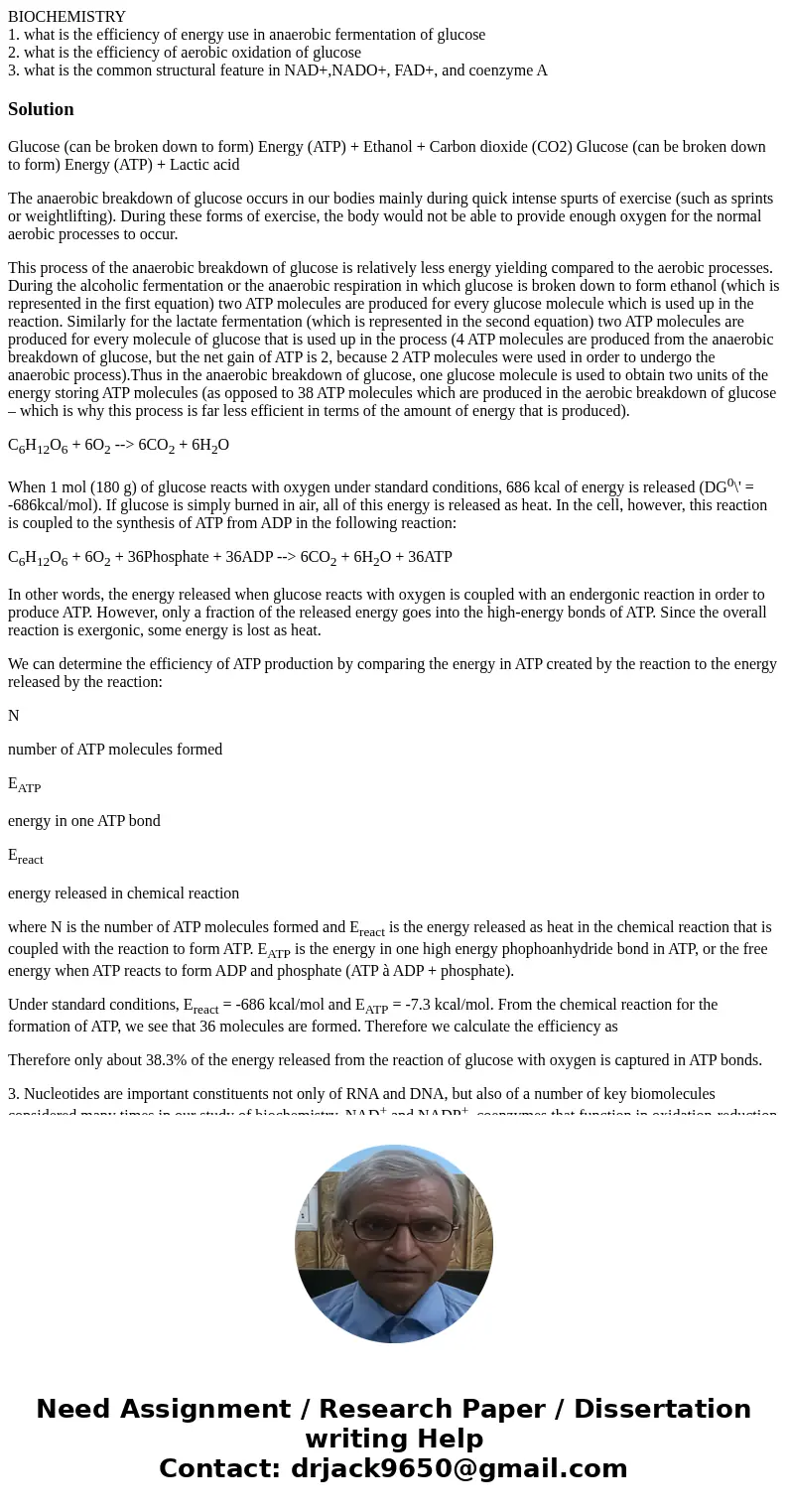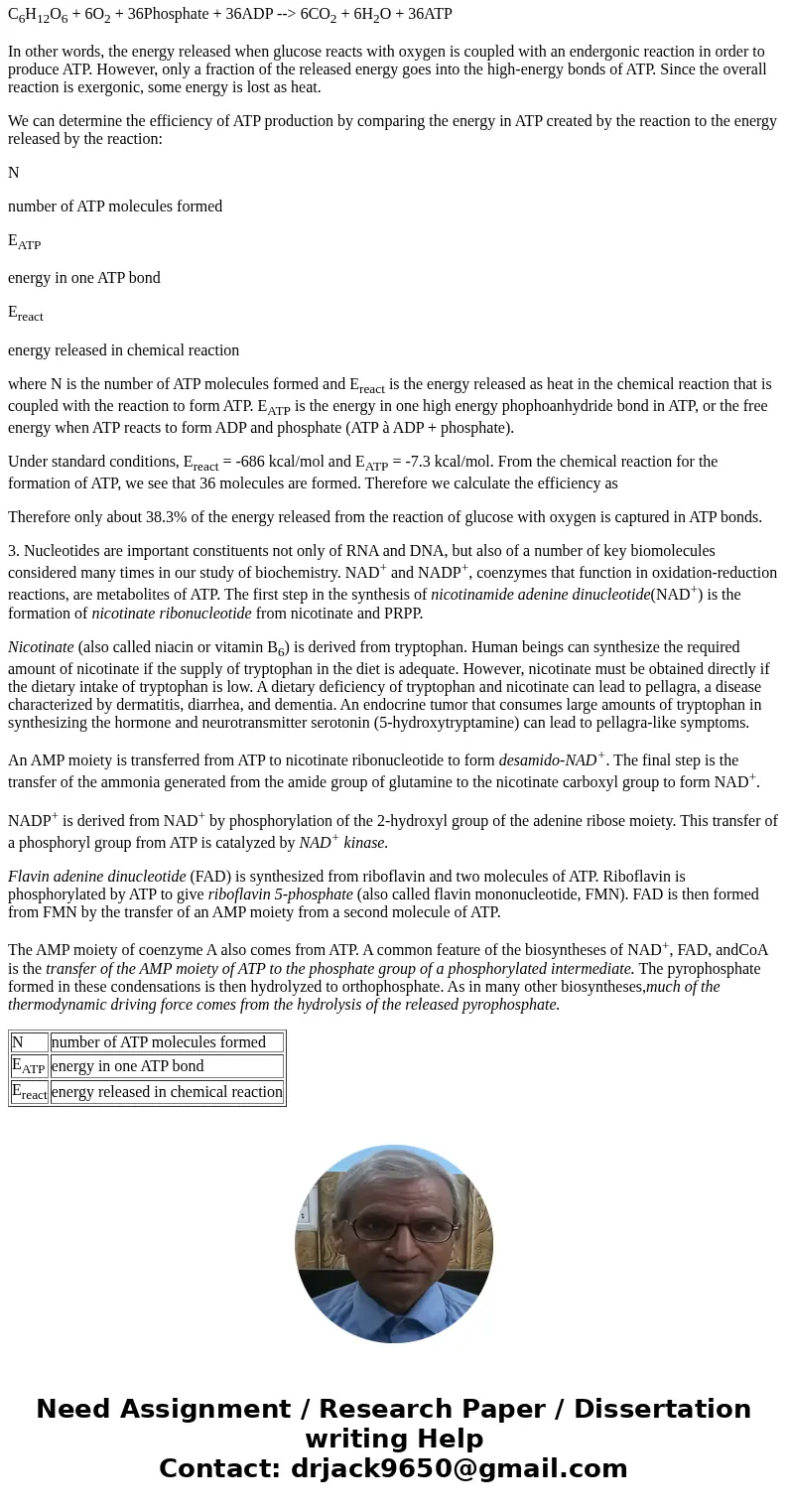BIOCHEMISTRY 1 what is the efficiency of energy use in anaer
BIOCHEMISTRY
1. what is the efficiency of energy use in anaerobic fermentation of glucose
2. what is the efficiency of aerobic oxidation of glucose
3. what is the common structural feature in NAD+,NADO+, FAD+, and coenzyme A
Solution
Glucose (can be broken down to form) Energy (ATP) + Ethanol + Carbon dioxide (CO2) Glucose (can be broken down to form) Energy (ATP) + Lactic acid
The anaerobic breakdown of glucose occurs in our bodies mainly during quick intense spurts of exercise (such as sprints or weightlifting). During these forms of exercise, the body would not be able to provide enough oxygen for the normal aerobic processes to occur.
This process of the anaerobic breakdown of glucose is relatively less energy yielding compared to the aerobic processes. During the alcoholic fermentation or the anaerobic respiration in which glucose is broken down to form ethanol (which is represented in the first equation) two ATP molecules are produced for every glucose molecule which is used up in the reaction. Similarly for the lactate fermentation (which is represented in the second equation) two ATP molecules are produced for every molecule of glucose that is used up in the process (4 ATP molecules are produced from the anaerobic breakdown of glucose, but the net gain of ATP is 2, because 2 ATP molecules were used in order to undergo the anaerobic process).Thus in the anaerobic breakdown of glucose, one glucose molecule is used to obtain two units of the energy storing ATP molecules (as opposed to 38 ATP molecules which are produced in the aerobic breakdown of glucose – which is why this process is far less efficient in terms of the amount of energy that is produced).
C6H12O6 + 6O2 --> 6CO2 + 6H2O
When 1 mol (180 g) of glucose reacts with oxygen under standard conditions, 686 kcal of energy is released (DG0\' = -686kcal/mol). If glucose is simply burned in air, all of this energy is released as heat. In the cell, however, this reaction is coupled to the synthesis of ATP from ADP in the following reaction:
C6H12O6 + 6O2 + 36Phosphate + 36ADP --> 6CO2 + 6H2O + 36ATP
In other words, the energy released when glucose reacts with oxygen is coupled with an endergonic reaction in order to produce ATP. However, only a fraction of the released energy goes into the high-energy bonds of ATP. Since the overall reaction is exergonic, some energy is lost as heat.
We can determine the efficiency of ATP production by comparing the energy in ATP created by the reaction to the energy released by the reaction:
N
number of ATP molecules formed
EATP
energy in one ATP bond
Ereact
energy released in chemical reaction
where N is the number of ATP molecules formed and Ereact is the energy released as heat in the chemical reaction that is coupled with the reaction to form ATP. EATP is the energy in one high energy phophoanhydride bond in ATP, or the free energy when ATP reacts to form ADP and phosphate (ATP à ADP + phosphate).
Under standard conditions, Ereact = -686 kcal/mol and EATP = -7.3 kcal/mol. From the chemical reaction for the formation of ATP, we see that 36 molecules are formed. Therefore we calculate the efficiency as
Therefore only about 38.3% of the energy released from the reaction of glucose with oxygen is captured in ATP bonds.
3. Nucleotides are important constituents not only of RNA and DNA, but also of a number of key biomolecules considered many times in our study of biochemistry. NAD+ and NADP+, coenzymes that function in oxidation-reduction reactions, are metabolites of ATP. The first step in the synthesis of nicotinamide adenine dinucleotide(NAD+) is the formation of nicotinate ribonucleotide from nicotinate and PRPP.
Nicotinate (also called niacin or vitamin B6) is derived from tryptophan. Human beings can synthesize the required amount of nicotinate if the supply of tryptophan in the diet is adequate. However, nicotinate must be obtained directly if the dietary intake of tryptophan is low. A dietary deficiency of tryptophan and nicotinate can lead to pellagra, a disease characterized by dermatitis, diarrhea, and dementia. An endocrine tumor that consumes large amounts of tryptophan in synthesizing the hormone and neurotransmitter serotonin (5-hydroxytryptamine) can lead to pellagra-like symptoms.
An AMP moiety is transferred from ATP to nicotinate ribonucleotide to form desamido-NAD+. The final step is the transfer of the ammonia generated from the amide group of glutamine to the nicotinate carboxyl group to form NAD+.
NADP+ is derived from NAD+ by phosphorylation of the 2-hydroxyl group of the adenine ribose moiety. This transfer of a phosphoryl group from ATP is catalyzed by NAD+ kinase.
Flavin adenine dinucleotide (FAD) is synthesized from riboflavin and two molecules of ATP. Riboflavin is phosphorylated by ATP to give riboflavin 5-phosphate (also called flavin mononucleotide, FMN). FAD is then formed from FMN by the transfer of an AMP moiety from a second molecule of ATP.
The AMP moiety of coenzyme A also comes from ATP. A common feature of the biosyntheses of NAD+, FAD, andCoA is the transfer of the AMP moiety of ATP to the phosphate group of a phosphorylated intermediate. The pyrophosphate formed in these condensations is then hydrolyzed to orthophosphate. As in many other biosyntheses,much of the thermodynamic driving force comes from the hydrolysis of the released pyrophosphate.
| N | number of ATP molecules formed |
| EATP | energy in one ATP bond |
| Ereact | energy released in chemical reaction |


 Homework Sourse
Homework Sourse